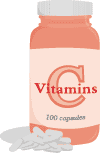New York's highest court of appeals has held that no-fault insurers cannot deny no-fault benefits where they unilaterally determine that a provider has committed misconduct based upon alleged fraudulent conduct. The Court held that this authority belongs solely to state regulators, specifically New York's Board of Regents, which oversees professional licensing and discipline. This follows a similar recent ruling in Florida reported in this publication.
New RDAs for Vitamins C, E
The Food and Nutrition Board of the Institute of Medicine has released new recommended dietary allowances (RDAs)* in the United States (recommended nutrient intakes [RNIs] in Canada) and tolerable upper intake levels (ULs)** for vitamins C, E and selenium.
Included in the report is a definition of dietary antioxidant, the term under which these nutrients fall: "A dietary antioxidant is a substance in foods that significantly decreases the adverse effects of reactive species, such as reactive oxygen and nitrogen species, on normal physiological function in humans."
New RDAs
Vitamin C (ascorbic acid) functions physiologically as a water-soluble antioxidant by virtue of its high reducing power. To provide antioxidant protection, the recommended dietary allowance (RDA) for adults for vitamin C is 75 mg/day for females and 90 mg/day for males (up from the previous RDA of 60 mg/day). This intake should maintain near - maximal neutrophil ascorbate concentrations with little urinary excretion. Because smokers suffer increased oxidative stress and metabolic turnover of vitamin C, their recommended intake has been increased by 35 mg/day.

Vitamin E is thought to function primarily as a chain-breaking antioxidant that prevents the propagation of lipid peroxidation. To estimate the requirement, data were examined on induced vitamin E deficiency in humans and the intake that correlated with in vitro hydrogen peroxide-induced hemolysis and plasma a-tocopherol concentrations. In addition, vitamin E acts as an in vivo anti-oxidant, maintaining normal physiological function in humans. The RDA for both men and women is 15 mg/day of a-tocopherol (previously 10mg/day for men and 8mg/day for women).

Selenium functions through selenoproteins, several of which are oxidant defense enzymes. The method used to estimate the requirement for selenium relates to the intake needed to maximize the activity of the plasma selenoprotein glutathione peroxidase, an oxidant defense enzyme. The RDA for both men and women is 55 micrograms (µg)/day.
While the RDAs for both vitamin C and vitamin E were increased, the RDA for selenium was decreased for men (from 70 µg/day) and remained unchanged for women. The report also provided tolerable upper intake levels (ULs) for adults for all three nutrients:
Vitamin C: 2,000 mg/day (based on the adverse effect of osmotic diarrhea).
Vitamin E: 1,000 mg/day (based on the adverse effect of increased tendency to hemorrhage).
Selenium: 400 µg/day (based on the adverse effect of selenosis).
These ULs were set to protect the most sensitive individuals in the general population (e.g., those who might be below reference adult weight). Members of the general apparently healthy population should be advised not to exceed the UL routinely.
* Recommended dietary allowance (RDA): the dietary intake level that is sufficient to meet the nutrient requirement of nearly all (97 to 98 percent) healthy individuals in a particular life stage and gender group.
** Tolerable upper intake level (UL): the highest level of nutrient intake that is likely to pose no risk of adverse health effects for almost all individuals in the general population. As intake increases above the UL, the risk of adverse effects increases.



